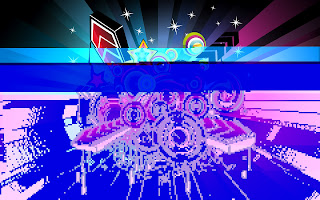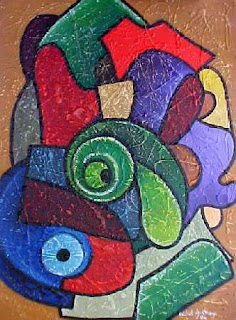Hello! Nice to see you again. Today is my last post, I hope it will be the best of all post I've made. I'm so happy to know that you still read my post until today. Maybe ussualy I make a few mistakes or maybe a few of my posts aren't clear enough. I'm so sorry abou it.
Today I want to tell you the real fact about abstract painting.The main idea of everything is just about your relationship with God and human. When you can combine it with all of your imagination and mix it into painting it will make an amazing abstract painting.
Let's review what you have learn. Do you still remember it? I hope you remember it. First thing that we have to know is painting with full heart, because from his painting we know what experience that he had experienced, or maybe like what character he had.
In the another part we learn about how to understand abstract painting. We have known that abstract painting is kind of art that can't be duplicated. And maybe the painter can't paint the same painting twice. So it was amazing right?
I wan to show you some of picture I have..
Let's review what you have learn. Do you still remember it? I hope you remember it. First thing that we have to know is painting with full heart, because from his painting we know what experience that he had experienced, or maybe like what character he had.
In the another part we learn about how to understand abstract painting. We have known that abstract painting is kind of art that can't be duplicated. And maybe the painter can't paint the same painting twice. So it was amazing right?
I wan to show you some of picture I have..
What do you think about three picture above? There are three kind of paintings. First is abstract painting, Second is Cubism painting, and the last is realistic painting. You can mix it together, free your imagination bring your mind and see how amazing was that.. haha..
Or maybe you want be creative like this..
Doesn't it interesting for you? Don't imprison your mind just on paper. Make it pleased, and surprise.. Use all of your imagination.. Don't forget to pray before you work.. hehe.. I think it will good when you pray before start working.
Or maybe you want more creative, like make it textured or make it on digital? See these picture..


How are they? Nice right? Next, we have learn about a few of technique paintings, and a few of basic technical of painting too. I hope what I have thought is useable anywhere. haha..
Today we will learn about color composition. These are the basic that you have to pay attention..
- The visual center of interest is attention, focus, the basic theme of a picture.
It is the most beautiful, worked through and expressive part art image. The area of surrounding supplies this major part and it is depended on. Try to define what details open most fully your plan and what create the second and even the third cent of the interest, competing with the basic theme.
It is the most beautiful, worked through and expressive part art image. The area of surrounding supplies this major part and it is depended on. Try to define what details open most fully your plan and what create the second and even the third cent of the interest, competing with the basic theme.
- The visual checkup. Our eye is located “to read” at the left on the right and from below in top. It likes to do a stop and to come back to passed. There is always should be pause for eyes. Avoid details, which do not emphasize the basic maintenance. Let the basic lines establish slow “research”. A visual line has smoothly to lead to the center of the basic attention. Straight lines create too fast trip for the spectator. Add some rhythm. Break direct way, alternate with contrasts.
- Everything comes back to painting. Branches of trees, a slope of mountain, movement of characters (animals, people, birds), everything looks and goes to the internal part of a picture. Movements of blows of a brush to the center help to create illusion of directions.
- Use the play of light and a shadow. It is a greater and interesting theme for studying! In fact, play of light creates all around, both mood and contrast, and also appoints significant.
- Investigate contrast. Excessive expressiveness on all canvas draws attention only at the first viewing. Further, eyes gets tired, no pauses, because all the details are “chewed” also struggle for your attention. It gives unreal rigid look. Learn to generalize and write only the main thing. Nobody loves excessive persistence. Allow the spectator to tell unsaid. Remain an opportunity for work of imagination.
- Illusions. A pure canvas and flat. How create illusion of three-dimensional space?
The key rule of depth: tone of background is always colder than forward.
Contrast and “chromaticity” is much fainter and they gradually gain in strength to forward plan. Soft sides on a background also promote creation of illusion of depth in painting.
Contrast and “chromaticity” is much fainter and they gradually gain in strength to forward plan. Soft sides on a background also promote creation of illusion of depth in painting.
- Investigate balance of forms, masses, color spots and movement in picture. Let any part of a canvas will not be overloaded. The good sketch before the beginning of work helps to define places of the basic forms of painting and also the form and the size of a canvas.
- Alternation of forms. Create a rhythm and balance in alternation of represented forms. For example, if the river in the foreground has smooth bends, let mountain or a cloud on a background have any smooth forms (or on the contrary).
- Colors should look harmoniously. Use no more than 3-4 shades in colour. Illusion of tone: our eye mixes by himself colors, which lay together. For example, dab of the red color, located near to white, gives illusion of pink color. It is a greater theme for research and creativity. Write light places more dense, shadow is thinner.
- Everything in the world searches balance. The spectator also unconsciously loves, when everything is harmonious and balanced. It would seem that the easiest way is to divide a canvas on two parts and to write something symmetric. It does not welcomed in the art world at all. Creativity assumes new decisions and search of balance there, where it cannot be on idea.
There was a concept “asymmetric balance”. Strangely enough, but exactly it gives a picture the center of appeal. The more complex this balance is the more it is interesting. An example: if instead of two identical, color masses will be placed three different under the form and color masses and besides, concerning each other – they will establish a certain line for viewing (from the big one to smaller one). A conclusion is that: search asymmetric decisions and not only under the form, but under color, contrast and rhythm.
These are a few of painting that I like to show you..
What do you think about tgree picture above? Isn't it good? Which one you like? I hope these picture can help you to find some reference.
If you have some question, you can comment it here, or maybe you can text me in 087859079015 or maybe my email victor_felix_45@yahoo.com .Thank you for your attention and good bye. Have a nice day.. God bless you..





















